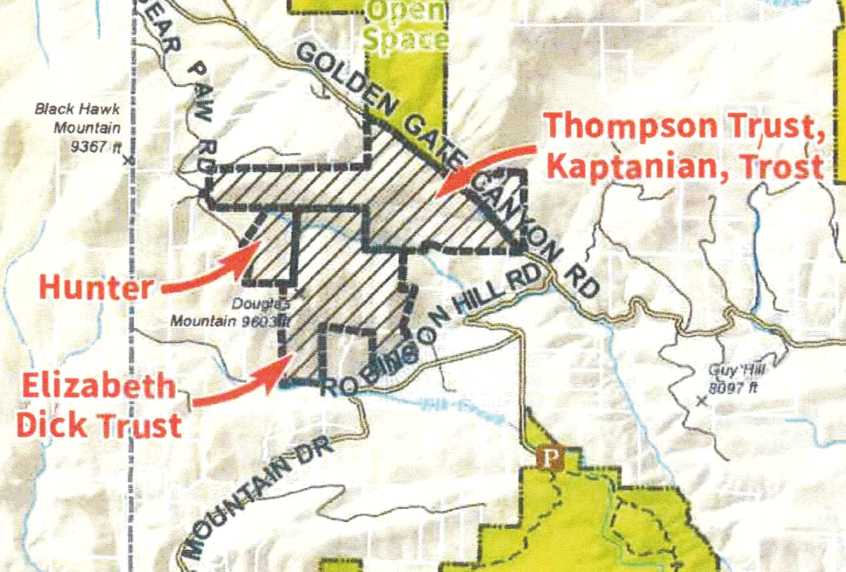Douglas Mountain Acquisitions
by John Litz
By the end of 2015, Jefferson County Open Space will have closed on three parcels of land totaling 1,036 acres that include the summit of Douglas Mountain. The map shows that most of the three properties are located west of the intersection of Golden Gate Canyon and Robinson Hill Roads. The small acreage to the north of the intersection contains the Centennial House, which was built of stone between 1872 and 1876. The building served as a stage stop for travelers along the historic Gregory Toll Road between Golden and Central City.
PLAN Jeffco has advocated for the acquisition of properties on Douglas Mountain for more than 20 years. We are pleased that the owners have allowed Open Space to preserve them.
The upper slopes of the southern part of the property have numerous locations that provide scenic views to the east and south – Mount Tom and Centennial Cone. The northeast side of the property is adjacent to 573 acres owned by Open Space that abuts the wildlife preserve portion of Golden Gate State Park. The southern boundary is about one mile north of Centennial Cone Park.
 The property is part of the ecosystem that contains drainage to both Clear Creek and Ralston Creek. Parts of the ecosystem were included in the “2010-2011 Survey of Critical Biological Resources in Jefferson County by the Colorado Natural Heritage Program”. The property on the west, Blackhawk Mountain, is forested with Douglas fir and aspen and supports a small, montane grassland. It was rated at “B-5 – General Biodiversity.” The property to the east, Mount Tom, supports limber pine, ponderosa pine, lodgepole pine, and Douglas fir. It was rated “B-3 – High Biodiversity.” The southern extent of the Douglas Mountain property was certified for the previous owners, through the American Tree Farm System, as a sustainable Tree Farm. A site visit by Open Space staff identified heartleaf arnica (Arnica cordifolia), which is an indicator of a healthy, highly functioning ecosystem.
The property is part of the ecosystem that contains drainage to both Clear Creek and Ralston Creek. Parts of the ecosystem were included in the “2010-2011 Survey of Critical Biological Resources in Jefferson County by the Colorado Natural Heritage Program”. The property on the west, Blackhawk Mountain, is forested with Douglas fir and aspen and supports a small, montane grassland. It was rated at “B-5 – General Biodiversity.” The property to the east, Mount Tom, supports limber pine, ponderosa pine, lodgepole pine, and Douglas fir. It was rated “B-3 – High Biodiversity.” The southern extent of the Douglas Mountain property was certified for the previous owners, through the American Tree Farm System, as a sustainable Tree Farm. A site visit by Open Space staff identified heartleaf arnica (Arnica cordifolia), which is an indicator of a healthy, highly functioning ecosystem.
The properties are included in the North Mountain Community Plan, which recommends preserving as much open space as possible, especially along the Golden Gate Canyon Road Corridor. The Plan also recommends diffusing the impacts of recreational development throughout the area. Public access probably will be from points on both Golden Gate Canyon and Robinson Hill Roads.
Open Space will take two years or so to study and understand the natural resources on the property. Then the planning group will look at the recreational possibilities of the property. Any development, probably, is at least five years away.



